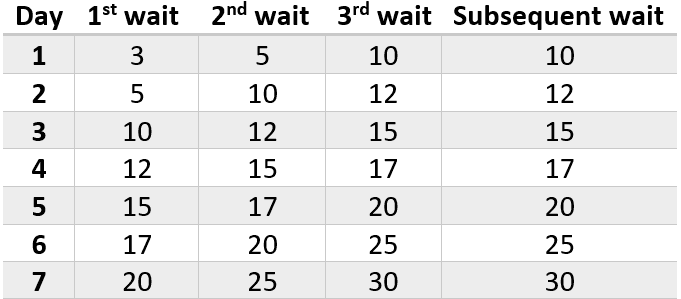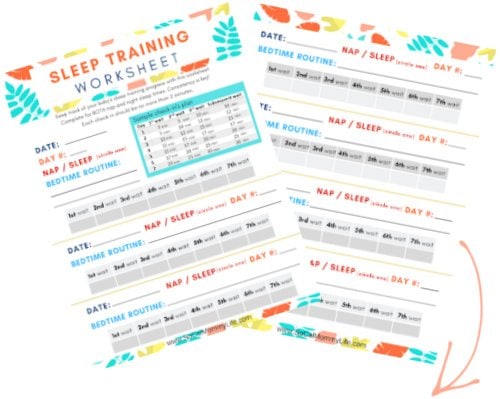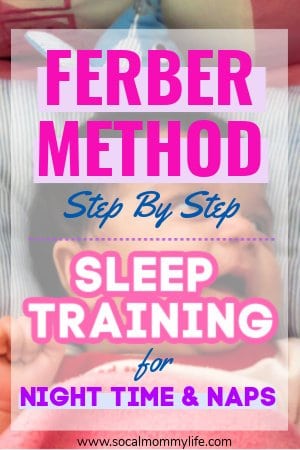You’re about to embark on a journey that every parent has to make–the decision on how to sleep-train their baby. And if you’re looking for the best Ferber method guide, then you need to know these 6 steps.

This post may contain affiliate links, which means I’ll receive a commission if you purchase through my link, at no extra cost to you. Please read full disclosure here.
The Ferber method is a sleep training technique that has been around for many years. It was developed by Dr. Richard Ferber, and it has helped countless families get their babies to sleep through the night. The Ferber method can be a bit controversial, but it’s definitely one of the most popular sleep training techniques out there.
In his book, Solve Your Child’s Sleep Problems, the Harvard professor purports to teach infants to learn how to fall asleep on their own.
I knew I was going to sleep train my son with the Ferber method the moment I read about it.
Like you, I was sleep-deprived. At 6 months old, baby W had no routine whatsoever. Some days he’ll nap 3 times and some days he’ll skip nap altogether. He used to get very cranky at night and I literally had to rock him in my arms for at least an hour before he dozed off (this is for both nap and bedtimes).
I was desperate for a sleep training program that gets me results fast but nothing extreme like leaving my baby cry himself to sleep
The cool thing about Ferberizing is that it teaches the baby the fundamentals of self-soothing. Falling asleep independently is a learned skill.
Once a baby masters that skill, he will be able to fall asleep unassisted and go back to sleep if he wakes in the middle of the night (aka sleep through the night)!
What You Need To Know About Ferberizing Before You Start Sleep Training
- Ferber method involves some degree of crying so it is not meant for babies younger than 3 months or weight less than 12 pounds. Regardless of what method you choose, your pediatrician will be able to tell you if your baby is ready for sleep training.
- Ferberizing doesn’t mean leaving the baby to cry without checking-in on her. Unlike the Extinction method where you leave the baby cry to sleep, the Ferber method involved crying for a specified period and periodic comforting on the caregiver’s behalf.
- Ferberizing isn’t just for nighttime sleep. It should be done for naps as well. Inconsistencies in nap and nighttime sleep training can be confusing for babies, undermining your sleep training efforts.
Step 1 – Watch For Snooze Clues
The very first step of this Ferber method guide is to make sure your baby is showing signs of sleepiness when you start sleep training.
Below is a list of common sleepy clues:
- Eye rubbing
- Yawing
- Less active/slower motion – baby will stop moving or lie on the floor
- Sucking is weaker from feeding
- Time being awake – for those following a routine
Anticipating your baby’s natural sleepy times at both naptime and bedtime will allow you to get your baby into sleep mode before he gets overtired. If a 6 months old baby has been awake for 3 hours, it’s probably time to go down.
Be mindful that an overtired baby (skips naps, catches brief catnaps, or doesn’t get enough sleep at night) will have a harder time settling down and sleeping longer stretches.
Fussiness, crankiness, and crying for no apparent reason are signs of overtiredness. Therefore, it is crucial to observe your baby for those early signs of sleepy cues.
Step 2 – Instill a Sleep-Friendly Environment
Baby needs to feel safe and comfortable in order to fall asleep.
Would you fall asleep or stay asleep if it’s too hot, too bright, or too noisy?
Make sure you consider the following:
- Set the thermostat to an optimal temperature (68 – 72 degrees Fahrenheit)
- Dress baby comfortably. A fleece onesie for wintertime, a short-sleeved pajama for the summer, and a wearable blanket for those who roll around
- Dark out curtain to keep lights away
- Use sound machines that play white noise or lullabies to help the baby fall asleep.
Wondering what are must-haves for successful sleep training?
![]() This list has everything you need to help your baby fall asleep alone!
This list has everything you need to help your baby fall asleep alone!
Step 3 – Put Baby in the Crib Awake
It can be VERY tempting to nurse or cuddle your baby to sleep. After all, who can resist that angelic face!
The point here is to teach your little one to fall asleep independently, not to rely on you to fall asleep. If you rock, sing or nurse her until she is snoozing, the lesson is not learned.
You want your baby to break the association that sleeping is to be rocked, singed, or nursed.
You are now teaching your baby to form a new association – ones where she’ll self-sooth and fall asleep without anyone’s help
After you’ve done the bedtime routine, put your baby down in her crib while she’s still awake and drowsy. The more drowsy your baby is, the shorter time for her to fall asleep.
If she is still fully alert, add more clam-me-down activities to your bedtime routine. These can include:
- Massage with baby-safe oil
- Read a bedtime book together
- Rock on the glider
- Sing a lullaby
- Play with sensory balls
Make sure you have the list of sleep training essentials before you put your baby down on Day 1.
Step 4 – Leave the Room
Turn off all lights, sounds, or anything stimulating and quietly leave the room. Your baby will cry and that’s ok. Think of it as a teaching opportunity for her to learn to fall asleep on her own.
Tip: If your baby starts to cry the moment you put her down, comfort her briefly (1 minute tops) by patting or shh-ing while she’s in the crib.
DO NOT pick her up again, turn on the lights, give her a pacifier, etc. Doing so will signal your baby to cry more to get your attention.
Step 5 – Check-In and Console
Wait about 3 minutes (1st wait) and go in to console her. Try not to turn on the lights and only do very gentle comforting like rubbing the back, patting, or shh-ing. Your purpose here is to assure your baby that she is in a safe place while she learns how to fall asleep independently.
Your check-ins should be 2 minutes tops. Take a timer with you if needed.
Wait for about 5 minutes (2nd wait) and repeat the process. From there, return to check-in at progressively increasing intervals to comfort your baby. Here is a sample check-in schedule.

We went by this schedule when we Ferberize both our kids. The first night, our son fussed for about 40 minutes before falling asleep by himself. But by the fourth night, he fell asleep just after the first check-in!
Download this handy sleep training worksheet to help with your check-in times ⬇️

Step 6 – Be Flexible on the Check-In Intervals
Every baby and parenting style is unique so adjust the amount of time between your check-ins as needed.
For example, if your baby is having a really hard time falling asleep, you can shorten your check-in intervals or use the same check-in intervals for a couple of days.
When ferberizing baby #2, we shortened our check-in intervals in the first couple of days. since unlike baby #1, Madi was a bad sleeper and got super mad whenever we left the room.
Even though we modified our check-in schedule for Madi, it only took us 2 extra days to get her sleep-trained compared to her older brother.
The first day of sleep training is the hardest but if you progressively increase your check-in intervals, your baby will soon learn how to fall asleep unassisted.
Ferber Method Sleep Training for Naps
Consistency is key for any sleep training method, and Ferberizing is no exception. Use the same “progressive waiting” approach for nighttime sleep as you would for your baby’s naps.
However, keep in mind that Ferberizing your baby at nap time will need to be slightly modified.
If your baby cries for over 30 minutes, then there goes the naptime. Consider setting a limit of a total of 10 or 15 minutes of crying.
It’s ok to slightly increase your baby’s nap time to accommodate for lost sleep from the previous night or nap. An overtired baby can be irritable and have a harder time falling asleep, which will make sleep training much harder.
It’s also a fine balance to not let your baby sleep too much or too late during the day which it eats into our baby’s nighttime sleep.
So, if your baby normally naps for 1 hour, let her sleep for an additional 30 minutes to make up for some lost snooze times.
Final Thoughts About Ferber Method Guide For Sleep Training
Baby W’s crying jags diminished steadily over 3 nights, and by the fifth night… drumroll, please… he fell asleep without a sound AND slept through the night!
We used the exact recipe to sleep train Madi when she turned 6 months old, and she is able to fall asleep by herself and stay asleep for 10+ hours.
Every nap and bedtime, we just put our babies in their cribs awake. They’ll toss and turn, and eventually fall asleep. Even when they wake in the middle of the night screaming, probably from nightmares, they’ll fall right back to sleep within minutes without anyone going in to comfort them.
When we traveled across the globe with baby W, he quickly got over his jetlagged spells because we stuck to the consistent strategies that got him to sleep trained in the first place.
I hope you find this Ferber method guide informative.
Now, you have everything you need to get started with sleep training your baby.
Before you start Ferberizing your baby, make sure to leave a quick comment to let me know what you think of this Ferber method guide!
Step By Step Ferber Method Guide To Successfully Sleep Train Your Baby
Ferber Method Guide Related Posts
- How to Get Your Child to Sleep Alone
- 14 Sleep Training Essentials for Your Baby
- How I Sleep Trained My 6-Month-Old in 5 Days
Save these pins now so you can come back to this article later! ⬇️





18 comments
I’ll save this for my next baby. This is brilliant.
This is the method we used to sleep train my first son. He was a horrible sleeper, but eventually it worked! He’s an amazing sleeper now.
Wow! I never knew this way until now, It’s definitely a great idea to put our baby to sleep. From now on, I’ll use this and make myself familiar with it. Thanks for sharing this with us.
Very interesting article. Thank you for sharing!
These are great tips for someone who wants to use this method!
We did this with both of our children, it was hard at first but it didn’t take long for the method to work and really did help them begin to fall asleep on their own without any issues.
I never used methods like this but I can see the benefits. That’s great that it worked well for your family.
I used this method with my daughter and it worked like a charm! Thanks for sharing!
This method is great to make sure child doesn’t feel totally ignored.
I’m so happy it worked for you! We tried this for more than a week and it was like my baby “reset” every time I went to check on him. I know it works for many, many people, but it just didn’t work for us (and I wish it had!).
It’s my first time hearing about this method. I’d give it a try first if this will be effective for my baby.
This is an interesting sleep training method. I never tried this one but I have heard a lot about it.
I used this method 47 years ago after reading his book and it worked like magic. I loaned the book to countless other parents who were so grateful they’d bring me gifts of appreciation However .. I can’t find anything on line about what the book says about refraining form. giving any kind of fluids to the baby/ child after early evening as it interferes with the REM apart of the seep cycle and wakes the baby / child up. I stopped the fluids gradually an ounce each night which my baby wasn’t happy about but within only 2 nights she stopped wakening up every hour of every night for a year. So just wondering if any new mums out there have come across refraining of fluids in Ferbres methods today as I can’t find it anywhere to show my daughter who is using it now with her daughter. Any pointers would be appreciated thanks.
In my experience, babies sleep better after they are fed (with milk). Especially if the bottle or breastfeeding is part of the bedtime routine. Every child is different though. If you find that refraining liquids before bedtime helps with your child’s sleep then continue doing so but please speak with your healthcare provider about it.
What do we do if the baby wakes during the night?
Hi Rebecca,
Try to wait a few minutes before you go in and console your baby. Try to keep the lights low and just gently pat for a few seconds and then leave the room. Progressively increase your check in time. Hope this helps!
What do you do if you can’t console your baby at check ins? My son will not settle down even after I come in to check on him. He is relentless and refuses to sleep until he he’s nursed and rocked to sleep each time. This goes for naps and bed time.
I have a 1 bedroom baby crib is in my room. I would love recommendations on how I would do this at night. I give up so easily when my baby cries. She is 5 months and thinking of trying this method. She is exclusively nursed.